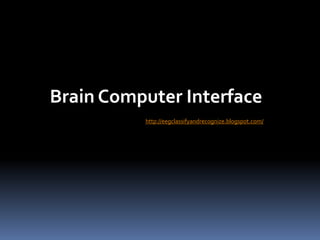1st seminar
- 2. Project Members ïžSupervisors âĒPro.Dr. Mostafa Gad-Haqq âĒPro.Dr.Tareq Gharib âĒDr. Howaida Abd El Fatah ïžAssistants âĒT.A ManalTantawy ïžTeam Members âĒAhmed KhaledAbd El-glil âĒAhmed MohamedAhmed Mahany âĒIslamAhmed Hamed âĒKamal Ashraf Kamal âĒMohammed Saeed Ibrahim
- 3. Agenda âĒ Problem Statement âĒ Objective âĒ Motivation âĒ Description ïž Introduction to EEG Signals ïž Brain Computer Interface âĒ Basic System Architecture âĒ Tools, technologies and SWE Methodology âĒ Time Plan âĒ References
- 4. Problem Statement Handicaps Handicaps need assistance to perform their everyday activities
- 5. Problem Statement Biometric Security High Risk Security
- 6. Problem Statement Medical Diagnose For Mental disorders and spinal injuries
- 7. Objective âĒ Help disabled people to normal life and communication without the need of others. âĒ Develop a generic EEG Classification that can support different applications âĒ Develop brain computer interface application by using cognitive EEG signal.
- 8. Motivation âĒ Help handicaps to normal life and communication without the need of others.
- 9. EEGsignal(Description ) âĒDefinition:- ïžAn electroencephalogram is a measure of the brain's voltage changes as detected from scalp electrodes. Electrodes: Small metal discs placed on the scalp in special positions.
- 10. EEGsignal(Description cont) âĒIt is an approximation of the cumulative electrical activity of neurons. âĒActions that affect the EEG signals to three categories:- ïžMuscular Movements ïžExpressive States ïžCognitive States (Our Scope)
- 11. EEGsignal(Description cont) âĒStudy of EEG paves the way for some problem:- ïžMonitoring Alertness, Coma, and Brain death. ïžlocating areas of damage following head injury and tumour. ïžInvestigating and testing epilepsy. ïžMonitoring the brain development. ïžinvestigating sleep disorders and mental disorders.
- 13. Brain Computer Interface(Description) Definition:- Brain Computer Interface (BCI) is a collaboration in which a brain accepts and controls a Mechanical device as a natural part of its representation of the body.
- 14. BrainComputerInterface(Descriptioncont.) What is it good for ? âĒPeople with little muscle control. âĒEarly medical diagnose ïžPeople with Amyotrophic lateral sclerosis(ALS) ïžSpinal injuries. ïžMental disorders.
- 15. Agenda âĒ Basic System Architecture âĒ Tools, technologies and SWE Methodology âĒ Time Plan âĒ References
- 16. Basic System Architecture Generic EEG Signals Classification Computer Interface
- 17. Basic System Architecture(cont) EEG Signal Pre-processing EEG Signal Classification EEG Signal acquisition ïž Emotive SDK Research Edition. ïžRemoval Noise ïžFeature Extraction âĒDFT âĒICATransforms âĒDiscreteWaveletTransform âĒAutoregressive Modeling ïžNeural Network ïžGenetic Algorithm ïžSupportVector Machine There are many algorithms to perform EEG signal feature extraction and classification Compare And Choose Computer Interface
- 18. Tools, technologies and SWE Methodology âĒ Tools &Technologies ïž Software ï Microsoft .NET Framework(Visual Studio 2008) ïž Hardware ï Emotive SDK Research Edition. âĒ Software development methodology ïž Agile.
- 19. Time Plan
- 20. References Books EEG Signal Processing Book Dr Saeid Sanei (Author), J. A. Chambers (Author). Papers Predicting ReachingTargets from Human EEG.[Paul S. Hammon, Scott Makeig, Howard Poizner, EmanuelTodorov, and Virginia R. de Sa] ,IEEE Signal Processing Magazine-jaunary 2008.
- 21. Thanks




















![References
Books
EEG Signal Processing Book Dr Saeid Sanei (Author), J. A.
Chambers (Author).
Papers
Predicting ReachingTargets from Human EEG.[Paul S. Hammon,
Scott Makeig, Howard Poizner, EmanuelTodorov, and Virginia R. de Sa]
,IEEE Signal Processing Magazine-jaunary 2008.](https://image.slidesharecdn.com/finalseminar-101126075027-phpapp01/85/1st-seminar-20-320.jpg)
